Port of Hamburg saw a slight rise in container throughput in the first quarter of the year but the positive start to 2022 was followed by a downturn with the outbreak of the Russia-Ukraine war which has since impacted its operations.
The German port recorded 2.2 million Twenty-foot equivalent units (TEUs) of throughput in the January to March period which was up 1.8% year-on-year. Meanwhile, its total seaborne cargo handling declined by 2.8% to 31.2 million tons compared to the same quarter of the previous year.
"The first quarter of the year brought very different trends for cargo handling, and traffic, for the Port of Hamburg," the gateway said in a statement.

It noted that the repercussions of the sanctions against Russia — only effective from March — were not yet apparent in all the handling segments for Germany’s largest universal port in the first quarter.
Downturn in container traffic from Russia
"After a very good start in January, the start of the war in Ukraine led to an extension of EU sanctions in trade with Russia during the course of February. In the Port of Hamburg we then rapidly noticed a downturn in container traffic with Russian ports," said Axel Mattern, CEO of Hamburg Marketing, noting that this was caused primarily by the reactions of many shipping companies in ceasing to call at Russian ports.
"Imports from Russian ports of coal, along with other bulk cargoes such as oil products, continued without being affected," he added.
Mattern pointed out that in the first quarter repercussions were already apparent in the general cargo sector, but that is meanwhile more obviously true in virtually all handling and industry segments.
For the quarter, Port of Hamburg noted that rail-borne freight traffic again "developed very well." It said that for the period, at 12 million tons the Port of Hamburg Railway handled a 1.6% greater volume. At 0.7 million TEU, 1.4% more containers were also transported.
"The Port of Hamburg once again confirmed its capability as a leading rail port. That was impressively underlined in January with record figures of 60,000 TEU per week and 231 train moves per day," Mattern said. "Against a background of especially high peak load at container terminals, and limitations in the rail network caused by storms, these records are noteworthy."
The Port of Hamburg executive added that despite the challenges, the port has been able to launch new container block train services.
"Delays to ships and off-schedule transport chains did however affect environment-friendly seaport-hinterland freight traffic by rail," Mattern added.
Port of Hamburg said rail's share of the modal split for container transport in Hamburg is meanwhile around 51.5%. Trucking takes 46.1%and inland waterway shipping, 2.4%.
First-quarter seaborne cargo handling
The port said totaling 22.5 million tons, general cargo throughput in the first three months of the year rose by 0.6%. Meanwhile, generating much added value, conventional general cargo handling at 0.4 million tons was up by a juicy 47.7% while bulk cargo handling throughput was weaker by 10.6% at 8.7 million tons in the same quarter of the previous year.
"Downturns in fertilizer exports and lower imports of coal, coke, and ore were the main factors there," the port said, noting that in the agribulk area, 1.6 million tons of suction goods were handled, the 5.2% downturn being mainly attributable to lower throughput of oleaginous fruits that were not completely offset by higher imports of grain and feedstuffs.
In the liquid cargo segment, at 2.3 million tons first-quarter throughput was 11.7%, lower imports being the main reason.
First-quarter container handling totaled 2.2 million TEU, noting a 1.8% gain.
"At 81%, the collapse in container traffic with Russian ports matched expectations. At the same time, we saw a steep increase in container services with Polish ports and those in the Baltic states. Larger volumes in traffic with these countries contributed towards offsetting the reduction in the Russian trade," Mattern commented.
China, USA, and Singapore head Hamburg's top ten partner countries for container handling.
The port said first-quarter container handling with China totaled 0.7 million TEU, representing a gain of 6.2% strengthening its position as Hamburg's most significant trading partner by a wide margin.
"With the high total of 18 liner services linking Hamburg with Chinese ports, even in Hamburg delayed ship arrivals are bringing home to us the special challenges created by handling bottlenecks caused by corona in some Chinese ports. Yet we managed to extend Hamburg's position as the leading port for China," said Mattern.
Uncertainties for full-year 2022
Port of Hamburg said in estimating the further trend in throughput for 2022, the "remains cautious."
"Yet some growth in specific segments and individual container trades is entirely possible," it added. "The overall result will be shaped by the anticipated downturn in throughput segments affected by sanctions."
Port of Hamburg said at year-end, the total throughput for 2022 will therefore be considerably below the volume of 130 million tons/nine million TEU anticipated prior to the Ukraine war.